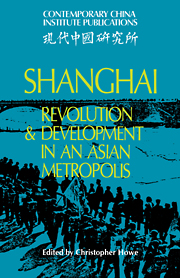Book contents
- Frontmatter
- Contents
- List of illustrations
- Preface
- Foreword
- Abbreviations
- PART ONE THE MODERN HISTORICAL PERSPECTIVE
- PART TWO POLITICAL LIFE
- PART THREE ECONOMIC DEVELOPMENT AND LIVING-STANDARDS
- PART FOUR THE SUBURBAN TRANSFORMATION
- 9 Shanghai–suburb relations, 1949–1966
- 10 The spatial development of Shanghai
- PART FIVE CULTURE AND IDEOLOGY
- Notes
- A chronology of modern Shanghai, 1842–1979
- Contributors
- Index
10 - The spatial development of Shanghai
Published online by Cambridge University Press: 14 October 2009
- Frontmatter
- Contents
- List of illustrations
- Preface
- Foreword
- Abbreviations
- PART ONE THE MODERN HISTORICAL PERSPECTIVE
- PART TWO POLITICAL LIFE
- PART THREE ECONOMIC DEVELOPMENT AND LIVING-STANDARDS
- PART FOUR THE SUBURBAN TRANSFORMATION
- 9 Shanghai–suburb relations, 1949–1966
- 10 The spatial development of Shanghai
- PART FIVE CULTURE AND IDEOLOGY
- Notes
- A chronology of modern Shanghai, 1842–1979
- Contributors
- Index
Summary
INTRODUCTION
From a geographical point of view, the increasing concentration of population in cities and the spatial growth of urban centres are significant components of the urbanization process.
Spatial growth of cities, involving the transformation of land use from rural to urban, has been closely associated with the urbanization experience of both developed and developing countries. The encroachment upon agricultural land in urban fringe areas by expanding cities constitutes a major problem. Fast but often disorderly growth has often brought about land speculation and inflation in land prices, greatly exacerbating the problem of acquiring land for public use. This problem is particularly acute in urban Japan. In developing countries in south-east Asia, the Middle East and Latin America, another problem of a different nature has also emerged. The urban fringe areas in these regions are characterized by the presence of squatter settlements erected by immigrants from the countryside. This illegal occupancy of urban fringe land has introduced confusion in land use, and presented thorny problems for the planned development of urban areas. In our view, these land use problems are as significant in the study of urbanization problems as the ‘urban ills’ generated by the high population concentrations or by the rapid increase of population in cities.
In this paper we shall investigate the character and pattern of spatial growth in China's major cities, with special reference to Shanghai, during the decade 1950–60 when China was undergoing intensive industrialization accompanied by a rapid rate of urbanization.
- Type
- Chapter
- Information
- ShanghaiRevolution and Development in an Asian Metropolis, pp. 269 - 300Publisher: Cambridge University PressPrint publication year: 1981
- 2
- Cited by

